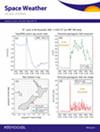F10.7 Daily Forecast Using LSTM Combined With VMD Method
IF 3.7
2区 地球科学
引用次数: 0
Abstract
The F10.7 solar radiation flux is a well-known parameter that is closely linked to solar activity, serving as a key index for measuring the level of solar activity. In this study, the Variational Mode Decomposition (VMD) and Long Short-term Memory (LSTM) network are combined to construct a VMD-LSTM model for predicting F10.7 values. The F10.7 sequence is decomposed into several intrinsic mode functions (IMF) by VMD, then the LSTM neural network is utilized to forecast each IMF. All IMF prediction results are aggregated to obtain the final F10.7 value. The data sets from 1957 to 2008 are used for training and the data sets from 2009 to 2019 are used for testing. The results show that the VMD-LSTM model achieves an annual average root mean square error of only 4.47 sfu and an annual average correlation coefficient (R) of 0.99 during solar cycle 24, which is significantly better than the accuracy of the LSTM model (W. Zhang et al., 2022, https://doi.org/10.3390/universe8010030), the AR model (Du, 2020, https://doi.org/10.1007/s11207-020-01689-x), and the BP model (Xiao et al., 2017, https://doi.org/10.11728/cjss2017.01.001). The VMD-LSTM model exhibits strong predictive capability for the F10.7 index during solar cycle 24.F10.7 使用 LSTM 结合 VMD 方法进行每日预测
众所周知,F10.7 太阳辐射通量是一个与太阳活动密切相关的参数,是衡量太阳活动水平的关键指标。本研究将变异模式分解(VMD)和长短期记忆(LSTM)网络相结合,构建了预测 F10.7 值的 VMD-LSTM 模型。VMD 将 F10.7 序列分解为多个固有模式函数 (IMF),然后利用 LSTM 神经网络预测每个 IMF。所有 IMF 预测结果汇总后得到最终的 F10.7 值。1957 年至 2008 年的数据集用于训练,2009 年至 2019 年的数据集用于测试。结果表明,VMD-LSTM 模型在太阳周期 24 期间的年均均方根误差仅为 4.47 sfu,年均相关系数(R)为 0.99,明显优于 LSTM 模型(W. Zhang 等,2022,https://doi.org/10.3390/universe8010030)、AR 模型(Du,2020,https://doi.org/10.1007/s11207-020-01689-x)和 BP 模型(Xiao 等,2017,https://doi.org/10.11728/cjss2017.01.001)的精度。VMD-LSTM模型对太阳周期24期间的F10.7指数具有很强的预测能力。
本文章由计算机程序翻译,如有差异,请以英文原文为准。
求助全文
约1分钟内获得全文
求助全文

 求助内容:
求助内容: 应助结果提醒方式:
应助结果提醒方式:


